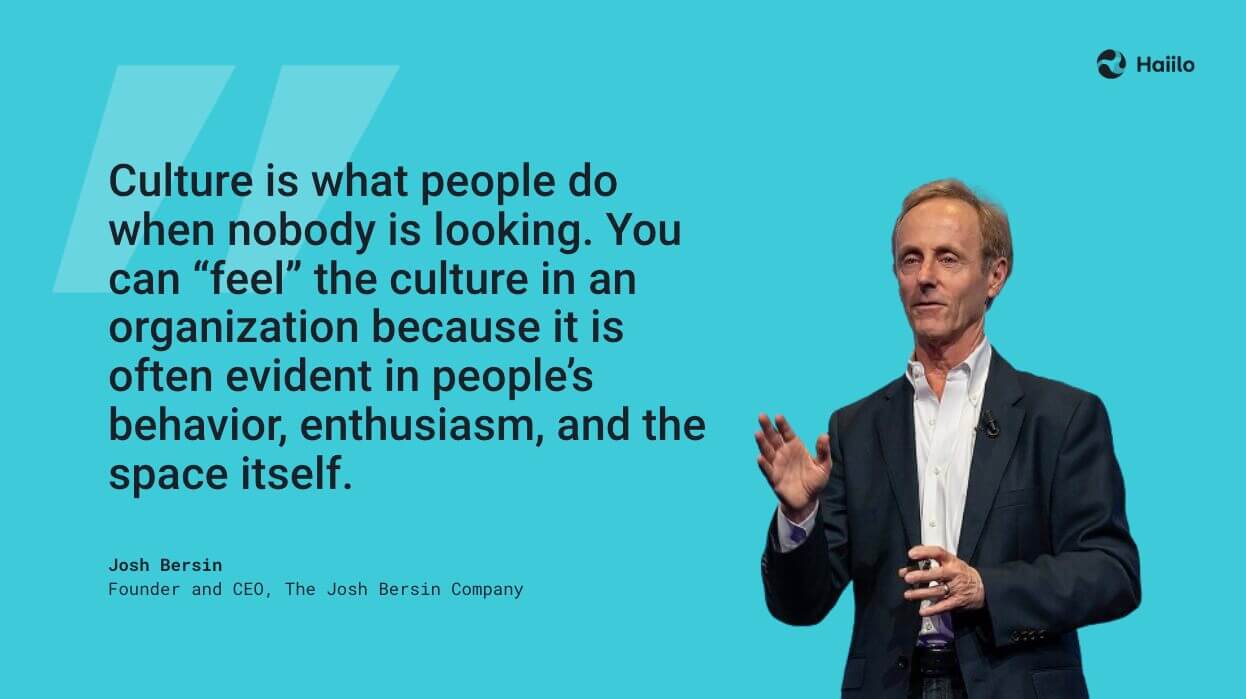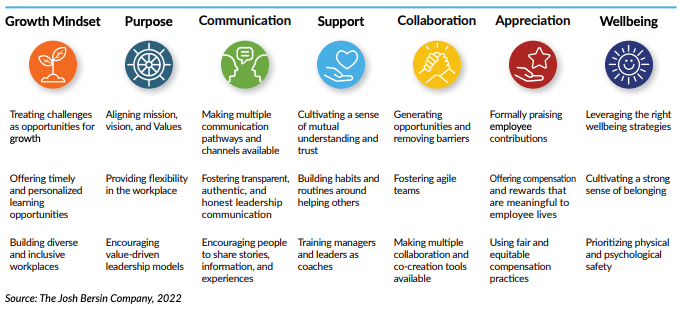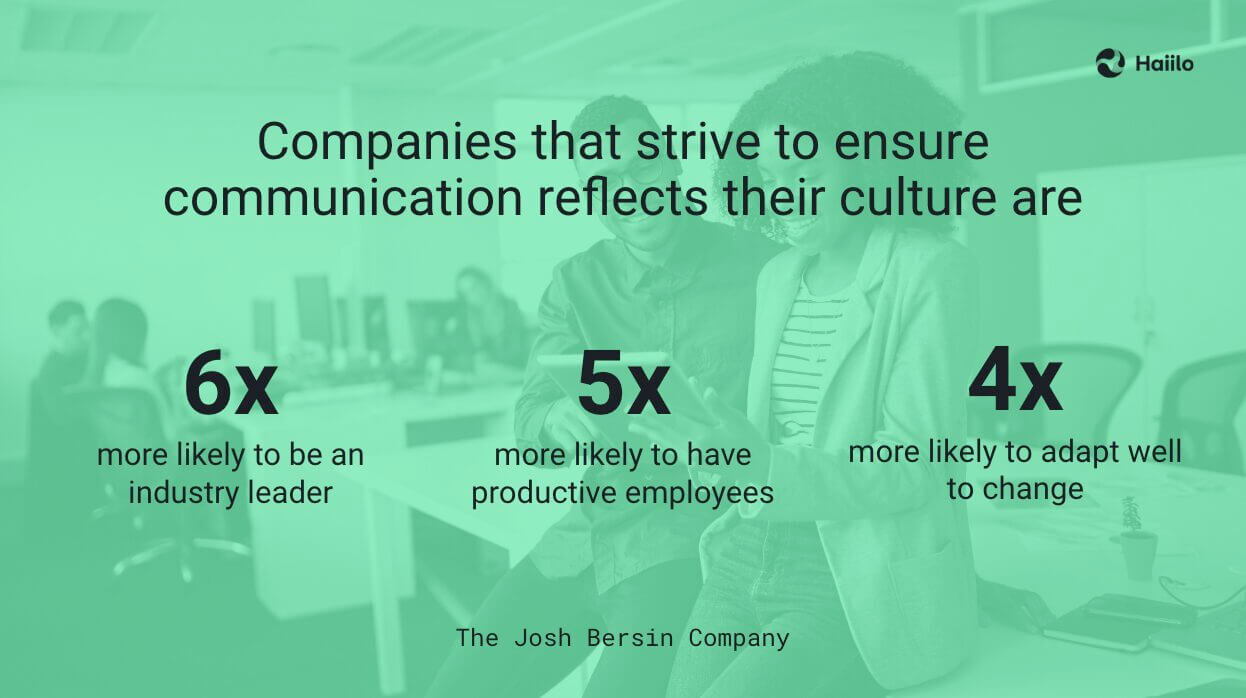How to improve company culture? A question most employers struggle to find a simple answer to. Culture is not a simple term and it’s not easy to define it. But if you understand its main factors and building blocks, you can also work on improving it.
In this blog, we will explain the company culture framework to help you understand what defines a culture, after which we will dig deeper into ways to improve your company’s culture and the overall employee experience.
Company Culture Defined
There is no single perfect definition of company culture. Leaders and culture professionals have different views about it, but we particularly like a definition by one of the biggest people experts and employee experience thought leaders Josh Bersin.
As explained by Josh:

Remember that culture is important because it drives alignment and teamwork. Culture is not a nice to have, it is a survival strategy for every company.
Understanding Company Culture Framework
Many different elements of company culture have a significant impact on the overall employee experience and the ultimate business goals.
However, certain elements have proven, over the years, to have the biggest impact on employee engagement, motivation, morale, performance, and retention.
Based on studies of thousands of organizations and millions of data points, combined with hundreds of deep-dive interviews in employee experience; organizational design; diversity, equity, and inclusion; well-being; learning and development; and talent acquisition, The Josh Bersin Company has developed its Culture Framework:

To summarize the image, a strong organizational culture is an environment in which employees are encouraged and enabled to grow and do their best, have a strong sense of belonging, collaborate efficiently with their peers and managers, are appreciated for their work, and are connected to the core company values, mission, and vision.
Let’s now dig deeper into the specific actions you can take to improve the company culture in your organization.
Strengthen your company’s culture with Haiilo!
How to Improve Company Culture In Your Organization
Looking to improve your company’s culture and create a happier workplace? Keep reading the following section that digs deep into what it takes to create an irresistible organizational culture.
1. Ensure better organizational alignment
As explained by Josh Bersin:
Purpose is that rare alignment between the walk and the talk: the why a company is in business and the actions it takes to accommodate that.
This sense of unity and purpose comes from something deeper than just strategy or skills; it comes from cultural alignment and involves aligning the individual values of your employees with the core values and objectives of your company.
When this is achieved, the overall company culture strives because employees don’t just work for a paycheck but believe in what they do and why they do it.
2. Enable proper communication and collaboration
Today, employees expect to always be connected with and have quick access to their peers, information, tools, documents, and conversations.
Connected workplaces, naturally, have healthier workplace cultures.
So employers need to focus on and develop more sophisticated multichannel communication strategies in order to touch the right people at the right time with the right content, make people more productive, and enable better team and cross-company collaboration.

Furthermore, leadership teams and internal communications professionals should always strive towards greater workplace transparency to build more trust in the workplace. And trust is one of the most important drivers of a strong company culture!
3. Create a psychologically safe environment
A psychologically safe workplace is a place where employees feel safe and encouraged to share their ideas, express concerns, ask questions, suggest improvements, and learn from mistakes.
Such workplaces enjoy a positive workplace culture which enables every person to strive and achieve their best.
When managers create a safe environment to express ideas and make suggestions, employees are also 31 times more likely to think their workplace is a breeding ground for innovation. Workplaces that have innovative cultures inspire employee loyalty, confidence, and willingness to give extra.
Additionally, there are incredible downsides of not having psychological safety, including negative impacts on employee well-being, including stress, burnout, and turnover, as well as on the overall performance of the organization.
4. Go beyond diversity, equity, and inclusion
Popular HR influencer, Brene Brown, says,
We need to do more than diversity and equity and inclusion. We need to create real belonging in our culture.
In her own business, Brown has reframed diversity, equity, and inclusion (DEI) efforts as DEIB, which stands for Diversity, Equity, Inclusion, and Belonging.
Furthermore, the Achievers Workforce Institute defines belonging as an experience of connection, security, and community — it’s about feeling at home in one’s place, without reservation.
According to APA’s 2023 Work in America workforce survey, 94% of respondents reported that it’s somewhat or very important to them that their workplace be somewhere they feel they belong. Consequently, the sense of belonging is one of the most important factors shaping positive workplace culture.
The results? Employees who feel a sense of belonging are 3 times more likely to look forward to coming to work and 5 times more likely to want to stay at the company for a long time.
5. Recognize hard work and achievements
Employee recognition and appreciation help employees feel valued and understand how their work contributes to the overall business success. It helps them have a sense of accomplishment and drives employee morale and motivation.
Research shows that recognition has the most impact when it is embedded in the workplace culture, but new data from Gallup and Workhuman reveal that only 34% of employees say their employer has a recognition program — and among those employees, just 13% rate it as “excellent.”
The good news is that employee recognition programs don’t have to be expensive and require additional budget. Moreover, many employees are more motivated by non-monetary than monetary rewards.
💡 Not sure how to get started? Check out our guide for launching an employee recognition program!
6. Coach your leaders to adopt the right leadership styles
Employees at great workplaces with strong company cultures find their people managers and leaders to be more credible: According to Great Place to Work research, 83% of employees at the 100 Best Companies said management’s actions match its words, versus 42% of employees at the average workplace.
There are specific leadership styles every leader should try to adopt and employers should support them in their journey.
These 2 leadership styles can help you improve the overall culture in your organization:
- Empathetic leadership focuses on identifying with others and understanding their point of view, their needs, and their challenges. Empathetic leaders take a genuine interest in their people – they focus on understanding what makes them tick and what inspires and motivates them.
- Servant leadership occurs when the leader’s main goal and responsibility is to provide service to their people. The leader ensures that his or her followers are growing and developing in all areas — their profession, knowledge, autonomy, and even their mental health and physical development.
📹 Check out our Masterclass Best Practices for Managers to Improve Internal Communications.
7. Adopt the right workplace technology
Proper workplace technology is critical for enabling organizations to improve many different segments of the previously mentioned culture framework.
For example, social intranets and internal communications tools are important for ensuring greater organizational alignment, improving employee communications, connecting employees, encouraging employees’ share of voice, and driving more teamwork and collaboration.
Survey solutions are critical for enabling employers to understand their employees, collect valuable feedback and data, and take appropriate actions to prevent disengagement and turnover.
How To Measure Company Culture
You need to be able to measure your company culture to improve it. If you don’t understand the current state of your organizational culture, it’s hard to understand the gaps and take appropriate actions for improvement.
So employers should regularly send employee surveys that measure different aspects of company culture.
Here are 10 questions you can include in your culture surveys:
- Do you feel connected to the work you do?
- Do you feel connected with your peers and your manager?
- Are you motivated by the mission of the company?
- Do you feel like you belong to your organization?
- Do you feel like leadership is transparent enough?
- Do you feel recognized and appreciated for your contributions?
- Do you trust your employer?
- Do you feel a sense of psychological safety while at work?
- Do you feel the perspectives of people from all cultures and backgrounds are respected and valued?
- Do you feel supported by your manager?
After collecting feedback, ideally your survey solution won’t just raw data but valuable insights with actionable recommendations for improvement.
💡 Looking for other employee surveys to implement in your organizations, check out these 60 employee survey questions.










